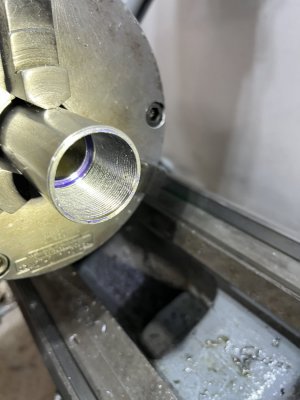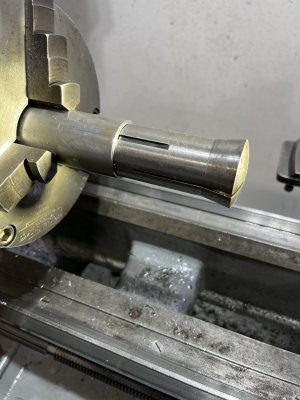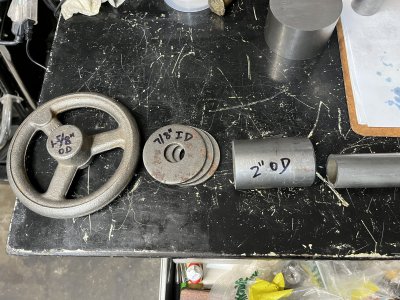- Joined
- Aug 1, 2022
- Messages
- 137
So threading was a disaster. 20 TPI, so any marking on the thread dial, right?
The scratch pass was good, matches the thread gage. A few more passes looked good, then all my Dykem blue disappeared after a whole bunch of passes.
I then noticed that the threads didn’t look very thread-like. Looked like something got cross-threaded.
Anyway, I have plenty of length. I parted it (which surprisingly went better than I expected), and started boring again.
Not sure what I did wrong on the threading. I’m using the compound to feed (~29.5 degrees), with a dial indicator on the tool post. I was disengaging the half nut, fed the cross slide in, slid the apron back, re-zeroed with the cross feed, advanced the thread tool with the compound and re-engaged the half nut at one of the lines on the thread dial.
When I try it again, I’ll err on the side of caution and pick one of the numbered lines and stick with that for subsequent passes.
Worse case scenario would be too much play somewhere on the lathe’s drivetrain, which would be bad…
Any advice? Thanks.
The scratch pass was good, matches the thread gage. A few more passes looked good, then all my Dykem blue disappeared after a whole bunch of passes.
I then noticed that the threads didn’t look very thread-like. Looked like something got cross-threaded.
Anyway, I have plenty of length. I parted it (which surprisingly went better than I expected), and started boring again.
Not sure what I did wrong on the threading. I’m using the compound to feed (~29.5 degrees), with a dial indicator on the tool post. I was disengaging the half nut, fed the cross slide in, slid the apron back, re-zeroed with the cross feed, advanced the thread tool with the compound and re-engaged the half nut at one of the lines on the thread dial.
When I try it again, I’ll err on the side of caution and pick one of the numbered lines and stick with that for subsequent passes.
Worse case scenario would be too much play somewhere on the lathe’s drivetrain, which would be bad…
Any advice? Thanks.





